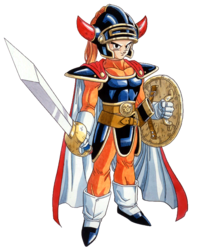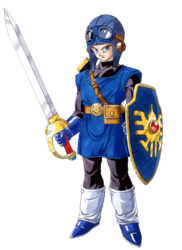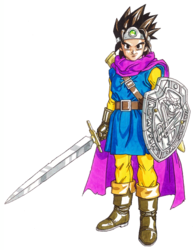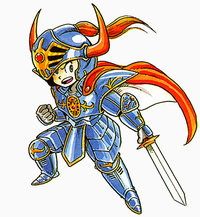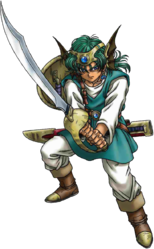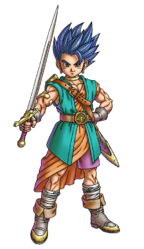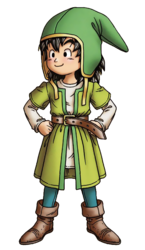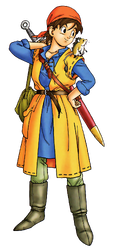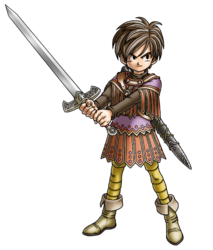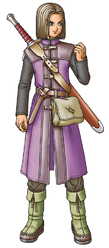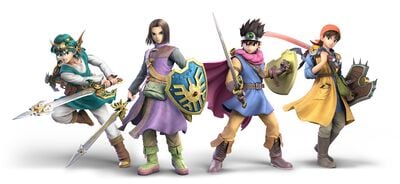Hero
- For fighter info, see Hero (SSBU).
| Hero | |
|---|---|
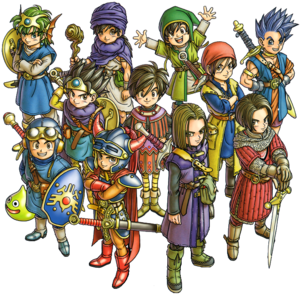  Official artwork of the Heroes from the first 11 installments of the mainline Dragon Quest series. | |
| Universe | Dragon Quest |
| Debut | Dragon Quest (1986, general concept) Dragon Quest III (1988, Erdrick) Dragon Quest IV (1990, Solo) Dragon Quest VIII (2004, Eight) Dragon Quest XI (2017, Luminary) |
| Smash Bros. appearances | Ultimate |
| Most recent non-Smash appearance | Dragon Quest Treasures (2022, Eight and Luminary) Dragon Quest Monsters: The Dark Prince (2023, Solo) Dragon Quest III HD-2D Remake (2024, Erdrick) |
| Console/platform of origin | Nintendo Entertainment System (general concept, Erdrick and Solo) PlayStation 2 (Eight) Nintendo 3DS, PlayStation 4 (Luminary) |
| Species | Human (Luminary and Erdrick) Human/Zenithian hybrid (Solo) Human/Dragovian hybrid (Eight) |
| Gender | Male (Luminary and Eight) Varies (Erdrick and Solo) |
| Created by | Yūji Horii |
| Designed by | Akira Toriyama |
| Voice actor | Mitsuki Saiga (Luminary) Nobuyuki Hiyama (Erdrick) Takeshi Kusao (Solo) Yuki Kaji (Eight) |
| Articles on Wikipedia | Hero (Dragon Quest III) Hero (Dragon Quest IV) |
The Hero (勇者, Hero) is a title given to the mainline protagonists from Square Enix's Dragon Quest franchise.
Origin[edit]
"Hero" is a collective title given to the protagonists of the Dragon Quest series, as their name (and in some cases, gender) is chosen by the player. The Hero is typically the most well-rounded character accessible to the player, skilled with both swordplay and magic. They typically have a wide range of equipment available to them, including the most powerful weapons and armor. As a result, the Hero is generally the character that the player will use the most throughout their quest. Additionally, very few of the Heroes have official names.
Dragon Quest[edit]
The Hero is given the title "Scion of Erdrick" (ロトの血を引く者, Scion of Loto) in Theatrhythm Dragon Quest, Dragon Quest: Monster Battle Road and Dragon Quest Rivals.
His name in the Japanese CD Theater audio drama and novelization is Alef (アレフ). Alef is borrowed from Alefgard (アレフガルド), the geographical name of the game's world. The Japanese Wii release of the game has the Hero's name as Solo (ソロ), a name which was also used for the Hero of Dragon Quest IV. He is uncommonly referred to as simply Erdrick (ロト, Loto), though the protagonist of Dragon Quest III is more commonly associated with this title.
The Scion of Erdrick does not have much character, simply being a stoic, silent hero for the player to assume the role of though he does have one line at the end of the game. He had an audience with the king of Alefgard, left for a dangerous journey and rescued Princess Gwaelin, defeating the Dragonlord and bringing the world to peace. Dragon Quest Builders, which takes place in an alternate timeline where the Hero instead joins forces with the Dragonlord, depicts him as a crazed villain who resides in a small fortress, believing himself to be the king of the world. Notably, unlike the other Heroes, this Hero has no companions whatsoever and as such travels completely alone.
Dragon Quest II: Luminaries of the Legendary Line[edit]
The Hero is known as the "Prince of Midenhall" (ローレシアの王子, Prince of Lorasia), a title also used in Theatrhythm Dragon Quest and Dragon Quest: Monster Battle Road. Midenhall was established by the Scion of Erdrick, making the Prince a direct descendant to the original Hero.
His name in the audio drama and novelizations is Allen (アレン). The manual of the Japanese Wii version of Dragon Quest II gives his name as Loran (ロラン). Loran is borrowed from Lorasia (ローレシア), the Japanese name for Midenhall.
Similar to the Dragon Quest Hero, the Prince does not have much personality, but is shown through his actions to be incredibly strong-willed and eager to defend his kingdom from the villainous cult leader, Hargon. He is joined by his cousins, the Prince of Cannock and the Princess of Moonbrooke, in his quest. Unlike most other Heroes, he does not possess any magic capabilities.
Dragon Quest III: The Seeds of Salvation[edit]
The Hero is given the title "Legendary Hero" (伝説の勇者) in Theatrhythm Dragon Quest and Dragon Quest: Monster Battle Road; in other instances, such as promotional material, their name is Arus (アルス, occasionally romanized as Arusu and sometimes Alus).[1] However, at the end of their adventure in Dragon Quest III, the Hero receives the title of Erdrick (ロト, Loto), which becomes their most widely known moniker. They are the first Hero to have male and female variations, though neither choice affects the story in a major way.
Erdrick is a fabled Hero in the lore of the Dragon Quest universe, known for their bravery in saving Alefgard and its surrounding lands from both the Archfiend Baramos and the Master Archfiend Zoma. They are the ancestor of the Heroes from Dragon Quest and, by extension, Dragon Quest II. These characters belong to a group known as the "Descendants of Erdrick" (ロトの子孫たち, Descendants of Loto).
The legendary armor the Hero of the game wears at a later point, which goes on to reappear in several other games in the series, serves as the inspiration for a downloadable Mii Swordfighter costume, under the name "Erdrick's Armour".
Dragon Quest IV: Chapters of the Chosen[edit]
Like the previous installment, the player can choose the gender of the protagonist. The default names for the male and female Heroes in-game are Solo[1] (ソロ) and Sofia (ソフィア), respectively; these names are also used for their appearances in later games. In the audio drama, the Hero is named Ray (レイ), and in the official novelizations, his name is Yuuril (ユーリル).
From a young age, the Hero was prophesied to defeat the Demons and restore peace to the world. They were raised by foster parents in a hidden village, protected from the outside world until they became an adult. Following a failed assassination attempt led by Psaro the Manslayer, the 18-year-old Hero finds themselves alone in a ransacked village. They soon set out on a quest to discover their true identity and fulfill the prophecy.
Dragon Quest V: Hand of the Heavenly Bride[edit]
The Hero is given the title "Legendary Monster Tamer" (伝説の魔物使い) in Theatrhythm Dragon Quest and Dragon Quest: Monster Battle Road.
The default name for the Hero in-game in Japanese is Abel (アベル). The Hero's father initially suggests the name Madason (トンヌラ, Tonnura), but soon changes his mind (though, if the player picks the name "Madason" to begin with, the father will instead suggest "Erdrick," before changing his mind); regardless, the name is commonly used by fans to distinguish him. In other related material—the audio drama, the official novelizations, and Dragon Quest: Your Story, a computer-animated film based on Dragon Quest V—he is named Luca (リュカ).
Notably, this character is not the chosen Legendary Hero; rather, it is his union with his future bride that involves him with the prophecy to defeat the villainous Order of Zugzwang. Nonetheless, he possesses extraordinary bravery and a captivating presence that often convinces monsters to join his side. He also uniquely wields a staff as his signature weapon, though he can also wield swords as the other Heroes do.
Dragon Quest VI: Realms of Revelation[edit]
The Hero is known as the "Prince of Somnia" (レイドック王子, Reidock Prince).
He has many official names in Japanese. His default name in the games is Reck (レック), which is derived from the Japanese name of his kingdom, Reidock (レイドック). In the audio drama, his name is Will (ウィル); in the manga, his name is Botts (ボッツ); in the novelization, his name is Iza (イザ).
Upon awakening from a strange dream where he conflicts with an evil Dread King, this amnesiac and seemingly-average boy soon discovers he is part of a larger prophecy. His adventure through the kingdom of Somnia sees him exploring the parallel Dream World, meeting familiar companions, and ultimately coming to terms with his true identity.
Dragon Quest VII: Fragments of the Forgotten Past[edit]
In English promotional material, this Hero's default name is Auster. In the Japanese version of the game and the official manga, the Hero's default name is Arus (アルス), the same as the Dragon Quest III protagonist.
The Hero is much pluckier than his counterparts; he is the young son of a respected fisherman, and something of a doormat, allowing others to easily take advantage of him. When events transpire that transport him and his companions into the distant past, they quest to defeat the Demon King Orgodemir and restore a broken timeline.
Dragon Quest VIII: Journey of the Cursed King[edit]
In the manual for the PlayStation 2 version and in promotional screenshots, the Hero's default name is Eight (エイト), and is the first Hero to be named after the English lettering of their respective game.[1] One of his companions, Yangus, also calls him "guv" as an informal nickname which is also sometimes used by fans to distinguish him from the other Dragon Quest heroes.
The Hero is an amnesiac who lives in Trodain Castle, serving as the captain of its guard upon becoming an adult. He is always accompanied by a small mouse-like creature named Munchie, who resides in his jacket pocket. After the villainous court jester Dhoulmagus sets a curse on the land of Trodain, the unaffected Hero and his companions set out to defeat him, ultimately learning about his origins and the true nature of the curse. Something to note is that the events of Dragon Quest VIII are completely unrelated to Dragon Quest VII, abandoning the previously established pattern of mainline entries being written as trilogies (i.e. Dragon Quest I-III and IV-VI existing in a respective shared universe).
Dragon Quest IX: Sentinels of the Starry Skies[edit]
The Hero is commonly referred to as Nine (ナイン). Like in Dragon Quest III and Dragon Quest IV, the player can choose the gender of the protagonist.
The Hero is a member of the Celestrians, a race of angelic guardian deities that watch over humanity, perform good deeds, and tend to Yggdrasil—the world tree that allows for Celestrians to ascend to the Realms of the Almighty. However, disaster soon strikes, causing the Hero to fall to Earth and become a regular, mortal human. With a party of other travelers, the Hero roams the Earth to assist those in need and eventually return home.
Dragon Quest X[edit]
The Hero is commonly referred to as X (エックス) or Ten (テン). Like in Dragon Quest III, Dragon Quest IV, and Dragon Quest IX, the player can choose the gender of the protagonist.
Both the Hero and their sibling live in the small village of Etene. During a raid on the village, said sibling is kidnapped by monsters, and the Hero is killed in an explosion. The Hero's soul is then revived as one of five non-human species, launching a nontraditional quest in the world of Astordia. While canonically dubious, multiple versions of this Hero coexist in the same world and can interact with each other.
Dragon Quest XI: Echoes of an Elusive Age[edit]
The Hero is commonly referred to as the Luminary (勇者, Hero) or Eleven (イレブン)[1].
The Luminary is said to be the reincarnation of a legendary warrior named Erdwin, who defeated the Dark One Calasmos. On his sixteenth birthday, he participates in a coming-of-age ceremony in his hometown of Cobblestone with his childhood friend Gemma, wherein he learns of his destiny and sets out on a journey to fulfill it. However, he conflicts with the Kingdom of Helidor, as its king instead apparently believes he is the Darkspawn, an entity doomed to spread darkness across the world. In spite of many accusing him of being the Darkspawn, the Luminary forms many alliances during his quest, being joined by Erik, Veronica, Serena, Sylvando, Rab, Jade, and Hendrik.
It is later revealed that the King of Heliodor was being controlled by Mordegon, a dark incarnation of the ancient wizard Morcant, a twist that is revealed when the party reaches Yggdrasil. Mordegon later steals the Luminary’s power from him and uses it to take the Sword of Light from Yggdrasil. He also captures the Heart of Yggdrasil, causing a worldwide cataclysm. The Luminary sets off on another quest to find his allies and to defeat the fiends responsible for the chaos post-cataclysm, in the process regaining his power to at last defeat Mordegon and a returning Calasmos.
In Super Smash Bros. Ultimate[edit]
As a playable character[edit]
Hero appears as a newcomer in Super Smash Bros. Ultimate, with his and Banjo & Kazooie's inclusions being announced during the E3 2019 Nintendo Direct on June 11, 2019.[2] He is the second DLC character of Fighters Pass Vol. 1, and was released on July 30th, 2019.[1]
Hero is represented through four separate iterations, similarly to the Koopalings and Alph. The playable iterations are:
- Luminary, the protagonist of Dragon Quest XI and the default Hero. He wields the Supreme Sword of Light and Erdwin's Shield.
- Erdrick, the male protagonist of Dragon Quest III. He wields the Sword of Kings and Shield of Heroes (also known as Erdrick's Sword and Erdrick's Shield, respectively).
- Solo, the male protagonist of Dragon Quest IV. He wields the Zenithian Sword and Zenithian Shield.
- Eight, the protagonist of Dragon Quest VIII. He wields the Dragovian King Sword and Dragovian Shield. His mouse companion Munchie resides in his pocket.
According to a Famitsu column by Super Smash Bros. series creator Masahiro Sakurai, there are restrictions from Square Enix regarding which Dragon Quest protagonists can encounter each other. However, Super Smash Bros. Ultimate was given special exception in order to have the different Heroes as alternate character costumes. Eight's addition as an alternate character, in particular, was due to his popularity with Western fans.[3] Additionally, the Luminary was added and made the default Hero due to wanting to promote the then-upcoming Dragon Quest XI S coming out on the Switch. In a later interview with series creator Yuji Horii, it was revealed that the team did toss around the idea of adding the series mascot Slime, but they realized its limited moveset potential, so they went with Hero. Originally only two Heroes were planned, being Luminary and Erdrick, but it was decided this was too few to represent the series at large, so the number was doubled to four. The Hero from Dragon Quest V was also considered, but he was ultimately decided against due to his default weapon being a staff instead of a sword, and he was instead reduced to a cameo role in Hero's Final Smash and referenced as an alternate costume for Erdrick.[4] The Hero from the first Dragon Quest was also considered, but was dropped as there isn’t a unified image for him across media.
When Hero originally began development, he was planned to be silent, similar to previous Dragon Quest protagonists. However, with the addition of voice acting in the Japanese version of Dragon Quest XI S (as the localized version of the original Dragon Quest XI had voice acting from the beginning), plans were changed and voices for all four Heroes were added,[5] marking the first game with official voice acting for Erdrick, Solo, and Eight. Sakurai shared some pieces of trivia about each of the Heroes' voice actors and their recording sessions:
- Luminary's voice actress, Mitsuki Saiga, reprises her role from Dragon Quest XI S, thus technically making Ultimate her debut voicing the character. However, she was directed to have more energy in her vocals to better fit the style of the Super Smash Bros. series.
- Erdrick's voice actor, Nobuyuki Hiyama, notably voiced the adult Link in The Legend of Zelda: Ocarina of Time, Smash 64, and Melee. Of the four Heroes, his recording session was completed the fastest because of his extensive experience. Sakurai also notes that his performance can be recognized as Guy Shishioh from The King of Braves GaoGaiGar, a possible reference to the term "brave" being associated with the Dragon Quest franchise.
- Solo's voice actor, Takeshi Kusao, asked for a lot of detail on the backstory of the protagonist to help improve his performance.
- Eight's voice actor, Yuki Kaji, apparently dreamed of doing voice work for the Dragon Quest and Super Smash Bros. series, and he was enthusiastic to fulfill both dreams at the same time in Ultimate.
Assist role[edit]
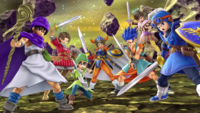
All the other iterations of the Dragon Quest Heroes also appear in Hero's Final Smash, Gigaslash.[1] The seven other iterations are:
- The protagonist of Dragon Quest.
- The protagonist of Dragon Quest II.
- The protagonist of Dragon Quest V.
- The protagonist of Dragon Quest VI.
- The protagonist of Dragon Quest VII.
- The male protagonist of Dragon Quest IX.
- The male protagonist of Dragon Quest X.
As a costume[edit]
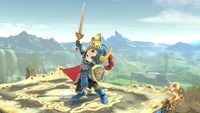
The Erdrick Equipment is a paid downloadable Mii Costume.[1] Although Erdrick's Helmet can be worn by any type of Mii Fighter, only Mii Swordfighters can wear Erdrick's Armour. While worn, the Mii Swordfighter uses the Sword of Kings instead of their standard sword.
Spirits[edit]
Names in other languages[edit]
| Language | Name |
|---|---|
| ロト | |
| Erdrick | |
| Elric | |
| Erdrick | |
| Erdrick | |
| Erdrick | |
| 羅德 | |
| 로토의 | |
| Erdrick | |
| Эрдрика |
Trivia[edit]
- Similar to Mewtwo, Hero has additional dialogue not present in the English version; he will call out the names of his neutral special, side special, and up special only when the language is set to Japanese, Chinese, or Korean.
- Hero is the only character with more than a single instant KO move, and the only one who has instant KO moves that aren't Final Smashes.
- Additionally, he is the only character that has an instant KO move that KOs himself.
- During Hero's reveal trailer, Hero lifts a barrel to reveal a Franklin Badge, which represents the action of discovering Mini Medals, a recurring collectible item across the series.
- Each of the four playable Heroes come from a different decade; Erdrick debuted in the 1980s, Solo debuted in the 1990s, Eight debuted in the 2000s, and the Luminary debuted in the 2010s.
- In Japanese and Chinese versions, the announcer reads the pronunciation of the kanji, "Yuusha", despite the game displaying the translated name of "Hero". This is unlike most other characters, who use the romanized version of their names.
- Due to Erdrick being designed by Akira Toriyama, his production company Bird Studio is credited for designing the Mii costume. Toriyama is also credited by name in the credits.
- Production company Armor Project is also credited for the Mii costume. Founder Yuji Horii, creator of Dragon Quest, is also credited by name.
External links[edit]
References[edit]
|
| |
|---|---|
| Fighter | Hero (SSBU) (XI, III, IV, VIII) |
| Stage | Yggdrasil's Altar |
| Other | Hero (I, II, V, VI, VII, IX, X) · Martial Artist · Mimic · Slime · Veronica |
| Spirits | Spirits |
| Music | Ultimate |
